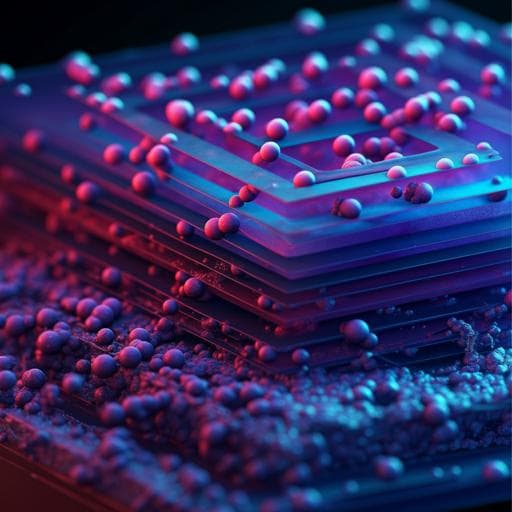
Physics
Observation of possible excitonic charge density waves and metal-insulator transitions in atomically thin semimetals
Q. Gao, Y. Chan, et al.
Discover groundbreaking insights into the metal-insulator transition in low-dimensional HfTe₂, revealing an excitonic insulator phase without lattice distortion. This research, conducted by Qiang Gao, Yang-hao Chan, Pengfei Jiao, Haiyang Chen, Shuaishuai Yin, Kanjanaporn Tangprapha, Yichen Yang, Xiaolong Li, Zhengtai Liu, Dawei Shen, Shengwei Jiang, and Peng Chen, sheds light on the electronic origins of charge density wave formation.
~3 min • Beginner • English
Introduction
Exciton condensation in semimetals can spontaneously occur at low temperatures when carrier densities are small and Coulomb interactions are weakly screened. Such condensation can produce charge density modulations and even drive a metal-insulator transition if interactions are strong. Low-dimensional layered materials with reduced screening are ideal for realizing this state. However, similar spectroscopic signatures (band renormalization, gap opening) can also arise from lattice-instability-driven structural transitions, complicating identification of the mechanism. A key discriminant is the observation of a metal-insulator transition without phonon softening. The study aims to determine whether atomically thin HfTe2 exhibits an electronically driven CDW consistent with an excitonic insulator, by probing temperature-, thickness-, and doping-dependent band structures and phonon responses.
Literature Review
The work is motivated by classic and modern studies of charge density waves and excitonic insulators: foundational theories of CDWs and excitonic phases (Grüner; Peierls; Mott; Keldysh & Kopaev; Jérôme, Rice & Kohn; Kohn; Halperin & Rice). Experimental and theoretical indications of exciton condensation have been reported in TMDCs and related systems, including TiSe2 (with phonon softening signatures), Ta2NiSe5 (excitonic instability with structural change), and monolayer systems (e.g., WTe2, MoS2 under pressure). Prior work on TiSe2 and ZrTe2 shows CDWs that may persist from monolayer to bulk or only at monolayer, often with structural contributions evidenced in phonon dispersions. HfTe2 is a semimetal with 0.2–0.3 eV indirect band overlap and no bulk transition reported, making it a candidate to test for an electronic CDW absent strong lattice distortions. Previous MBE growth and band-engineering studies of HfX2 (X = S, Se, Te) inform the electronic structure context.
Methodology
- Film growth: Single-layer and multilayer HfTe2 were grown by MBE on HOPG and on bilayer-graphene-terminated SiC (BLG/SiC). SiC substrates with varied resistivity (0.015–0.1 Ω·cm) provided tunable n-type doping. Substrates were prepared by flash annealing to form BLG. Growth used co-evaporation of high-purity Hf (e-beam evaporator) and Te (Knudsen cell) at 400 °C. Multilayers were post-annealed at 500 °C for 20 min. Growth rate: ~45 min per layer. RHEED monitored layer-by-layer growth and thickness via intensity oscillations.
- ARPES: Samples were transferred in situ or via vacuum suitcase to lab ARPES or SSRF beamlines. Measurements at base pressure ~5×10^-11 mbar using He I (21.2 eV) and 25–100 eV synchrotron photons with Scienta DA30 analyzers. Energy resolution <15 meV; angular ~0.2°. Fermi level referenced to polycrystalline Au. Crystallographic orientation determined from constant-energy maps. Carrier densities extracted from Luttinger areas around Γ and M; for cases without Fermi crossings, conduction-band tail analysis estimated densities via spectral-weight integration with Lorentzian spectral functions.
- Raman spectroscopy: Non-polarized backscattering with 633.1 nm HeNe laser; grating spectrometer with LN2-cooled CCD. Combined Bragg grating and notch filters enabled measurements down to ~5 cm^-1. Laser power <70 μW. Samples capped with ~6 nm amorphous Te and rapidly transferred to cryostat. Temperature range down to 1.6 K. Monitored phonon modes and potential emergence of CDW-related amplitude modes or zone-folded modes.
- X-ray diffraction: Surface x-ray scattering at SSRF BL02U2 with 9.8 keV incident energy; Eiger 500K detector. Performed reciprocal-space scans along Γ–M to detect potential half-order peaks from (2×2) distortions.
- First-principles calculations: VASP with PAW, plane-wave cutoff 520 eV (checked to 620 eV), k-mesh 20×20×1 (checked to 48×48). GGA-PBE; DFT-D3 for vdW in multilayers. Experimental in-plane lattice constants (a = 3.967 Å for 1 TL; 3.95 Å for multilayers). SOC included. Freestanding slabs with 16 Å vacuum. Phonons via Phonopy supercell (4×4), frequencies converged at Γ and M; additional runs at slightly different lattice constants; also PBE+U (U = 7 eV) tested. Topological invariants from hybrid Wannier center evolution using Z2pack.
Key Findings
- Temperature-driven metal–insulator transition in 1 TL HfTe2: ARPES shows at 250 K a metallic hole-like Fermi pocket at Γ with no nesting; upon cooling to 10 K, the top valence band flattens and a full gap opens at Γ, indicative of an insulating/semiconducting state.
- CDW signatures: Emergence of weak replica (backfolded) bands at M at low T consistent with a (2×2) folding; lower valence band at ~−0.57 eV does not show replicas due to weak coupling and large spin–orbit splitting.
- Gap magnitude and Tc: For 1 TL HfTe2/HOPG, gap Δ ≈ 83 meV at 10 K (underestimated because CBM is above EF). Electron-doped samples show similar gaps (e.g., 80 meV and 84 meV for n−p = −5.4×10^12/cm^2 and 1.5×10^12/cm^2, respectively) despite differing Tc. BCS-like fits to temperature dependence yield Tc values ranging from ~74 K to ~175 K across doping; in an n-doped film (n−p = −5.4×10^12/cm^2), Tc is ~2.3× higher than in HOPG-grown 1 TL.
- Strong-coupling indicators: 2Δ/kBTc ≈ 5.5 near balanced carriers (n−p = −5.4×10^12/cm^2) and increases to ~13.0 for carrier-imbalanced 1 TL HfTe2/HOPG, exceeding the weak-coupling BCS value 3.52.
- Thickness dependence: CDW gap and backfolded bands present for N < 3 TL; excitonic features vanish by 3 TL. Increasing thickness increases carrier density and screening. Estimated carrier densities: 1 TL p ≈ 7.0×10^12/cm^2 (Γ); 3 TL p ≈ 4.8×10^12/cm^2 (Γ) plus n ≈ 2.4×10^13/cm^2 (M).
- Doping dependence: Systematically tuning n−p via substrate-controlled n-doping shifts bands downward and introduces conduction bands at M. CDW gap and folding persist in lightly to moderately n-doped samples; highest Tc occurs near n ≈ p. Heavy doping suppresses Tc toward zero.
- Screening control: Tc decreases with increasing total carrier density n+p, consistent with screening suppressing exciton formation.
- Lattice response: Raman spectra of 1 TL HfTe2 show four modes at ~2.9, 3.3, 3.8, 4.4 THz (2E + 2A1) with no phonon softening, no amplitude modes, and no new zone-folded peaks down to 1.6 K; x-ray line scans detect no half-order peaks. Phonon calculations for N = 1–3 TL show no imaginary modes (only small acoustic dips at M), indicating absence of intrinsic structural instability to (2×2) within numerical accuracy. PBE+U (U = 7 eV) also finds no imaginary phonons.
- Topological context: DFT indicates band inversion and nontrivial Z2 topology for N ≥ 2 TL, suggesting potential for topological excitonic insulating phases.
- Representative doping set: n−p values studied include −7.0, −5.4, −3.7, +1.5, and +8.3 ×10^12/cm^2.
Discussion
The combined ARPES, Raman, x-ray, and first-principles results indicate that the observed low-temperature insulating state with (2×2) band folding in monolayer and few-layer HfTe2 is driven by electronic correlations rather than lattice instabilities. The absence of phonon softening or emergent Raman modes across the transition, together with phonon spectra lacking imaginary frequencies, rules out a Peierls-type (structural) CDW as the primary mechanism. The strong layer and doping dependencies of Tc, correlating inversely with total carrier density (n+p), support a screening-governed formation of bound electron–hole pairs (excitons) with finite momentum, consistent with the excitonic insulator scenario. The enhancement of Tc when carrier imbalance is reduced (n≈p) and the large 2Δ/kBTc ratios further suggest strong-coupling excitonic condensation. Thickness-induced increases in density of states and screening naturally suppress the condensate by 3 TL. These findings directly address the central question of disentangling electronic versus lattice origins in CDW-like transitions and position low-dimensional HfTe2 as an intrinsic excitonic insulator platform.
Conclusion
This work demonstrates a temperature-driven metal–insulator transition with (2×2) band folding in atomically thin HfTe2 that is consistent with an electronically driven CDW arising from exciton condensation. Key evidence includes a full gap opening at Γ, backfolded bands at M, robustness of the gap across moderate doping, enhancement of Tc near carrier balance, suppression of Tc with increasing total carrier density and thickness, and the absence of phonon softening or structural superlattice signatures. First-principles phonon calculations corroborate the lack of structural instability. The results establish low-dimensional HfTe2 as a compelling intrinsic excitonic insulator and suggest routes to engineer and control the phase via doping and thickness. Given the predicted nontrivial topology for N ≥ 2 TL, HfTe2 offers opportunities to realize and study topological excitonic insulating phases and their interplay with other correlated orders. Future work should develop microscopic theories capturing doping- and density-dependent screening effects on excitonic condensation and explore device-level control of excitonic phases.
Limitations
- ARPES gap estimates can be underestimated when the conduction band minimum lies above EF; only with slight electron doping does the CBM enter below EF to better constrain Δ.
- Carrier densities inferred from Luttinger areas may be overestimated when bands do not cross EF; tail-based spectral-weight approximations introduce uncertainty.
- Raman and x-ray probes have finite sensitivity; very small lattice distortions or weak collective amplitude-mode signals could be below detection limits.
- DFT (GGA-PBE) has known limitations for semimetal overlaps and excitonic effects; although phonon calculations show no imaginary modes, subtle electron–phonon coupling effects beyond DFT accuracy cannot be entirely excluded.
- Matrix-element effects in ARPES influence band intensities and visibility of folded features, complicating quantitative comparisons across photon energies.
- The precise microscopic mechanism governing the doping dependence of Tc and the large 2Δ/kBTc ratio requires further theoretical treatment beyond mean-field BCS-like models.
Related Publications
Explore these studies to deepen your understanding of the subject.







